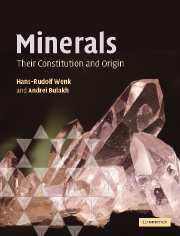Book contents
- Frontmatter
- Contents
- Preface
- Acknowledgments
- Figure credits
- Part I Structural features of minerals
- Part II Physical investigation of minerals
- Part III Variety of minerals and mineral-forming processes
- Part IV A systematic look at mineral groups
- 19 Important information about silica materials and feldspars
- 20 Simple compounds. Unusual mineral occurrences
- 21 Halides. Evaporite deposits
- 22 Carbonates and other minerals with triangular anion groups. Sedimentary origins
- 23 Phosphates, sulfates, and related minerals. Apatite as a biogenic mineral
- 24 Sulfides and related minerals. Hydrothermal processes
- 25 Oxides and hydroxides. Review of ionic crystals
- 26 Orthosilicates and ring silicates. Metamorphic mineral assemblages
- 27 Sheet silicates. Weathering of silicate rocks
- 28 Chain silicates. Discussion of some igneous and metamorphic processes
- 29 Framework silicates. Zeolites and ion exchange properties of minerals
- Part V Applied mineralogy
- Appendices
- Glossary
- References
- Index
- Plate section
- References
21 - Halides. Evaporite deposits
from Part IV - A systematic look at mineral groups
- Frontmatter
- Contents
- Preface
- Acknowledgments
- Figure credits
- Part I Structural features of minerals
- Part II Physical investigation of minerals
- Part III Variety of minerals and mineral-forming processes
- Part IV A systematic look at mineral groups
- 19 Important information about silica materials and feldspars
- 20 Simple compounds. Unusual mineral occurrences
- 21 Halides. Evaporite deposits
- 22 Carbonates and other minerals with triangular anion groups. Sedimentary origins
- 23 Phosphates, sulfates, and related minerals. Apatite as a biogenic mineral
- 24 Sulfides and related minerals. Hydrothermal processes
- 25 Oxides and hydroxides. Review of ionic crystals
- 26 Orthosilicates and ring silicates. Metamorphic mineral assemblages
- 27 Sheet silicates. Weathering of silicate rocks
- 28 Chain silicates. Discussion of some igneous and metamorphic processes
- 29 Framework silicates. Zeolites and ion exchange properties of minerals
- Part V Applied mineralogy
- Appendices
- Glossary
- References
- Index
- Plate section
- References
Summary
Introduction
About 120 minerals are halide compounds, characterized by the presence of halogen ions (Cl-, Br-, F-, and I-). Among them are the fluorides (e.g., CaF2: fluorite), chlorides (e.g., NaCl: halite), bromides (e.g., AgBr: bromargyrite), iodides (e.g., AgI: iodargyrite), halogen salts (e.g., Na3AlF6: cryolite), and oxihalogenides (e.g., Cu2Cl(OH)3: atacamite). The chlorine- and fluorine-bearing minerals are the most abundant and the most important ones are listed with some properties in Table 21.1. Halogens are minor components in other minerals such as topaz (Al2(SiO4)F2), phosgenite (Pb2(CO3)Cl2) and marialite (Na4(AlSi3O8)3Cl). In this chapter we discuss only the most common chlorides and fluorides, and emphasize their occurrence as evaporites, i.e., minerals that crystallize during evaporation of water from a supersaturated solution.
Common compositional and structural features of halides
Chlorine and fluorine are chemically very active elements and ionize easily by incorporating an electron. The Cl- and F- anions are fairly large and bond readily with metallic cations. The most widespread halogen compounds that occur in nature as minerals are the fluorides and chlorides of alkali and alkaline earth elements (sodium, potassium, calcium, magnesium, and strontium).
Some halide minerals (e.g., bischofite (MgCl2·6H2O), carnallite (KMgCl3·6H2O)) may contain molecular water in their crystal structure. This situation is particularly typical for the magnesium and aluminum fluorides, where water molecules compensate for the relatively small sizes of Mg2 + and Al3 + as compared with Cl- and F-.
- Type
- Chapter
- Information
- MineralsTheir Constitution and Origin, pp. 347 - 358Publisher: Cambridge University PressPrint publication year: 2004



